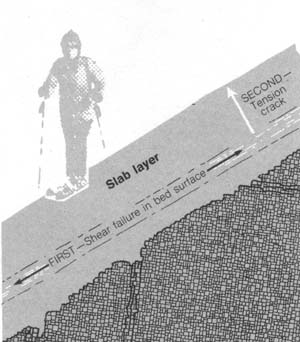BASIC PHYSICS OF SLAB AVALANCHES

Photo from Fredston and Fesler 1994

Figure from Perla and Martinelli 1976
Photo from Fredston and Fesler 1994
Slab avalanches are most often the greatest threat to backcountry travelers. There are two main components in the snow pack that need to be present for these to occur: a cohesive slab layer and a sliding layer underneath the slab (called the bed surface) which is characterized by poor layer bonding and low shear strength (University of Colorado IBS 1975; Perla and Martinelli 1976; Daffern 1983). A slab in the snow pack can be a surface layer, an intermediate layer, or the entire depth of snow. The bed surface serves as a sliding layer once breakaway forces have a magnitude greater than stabilizing forces. A typical scenario for the initiation of a slab avalanche is as follows (Perla and Martinelli 1976): shear failure occurs in the bed surface where there is weak bonding and this increases tensile stress in the slab (see figure below). When tensile stress exceeds the bonding strength, the slab fractures and separates from the slope at the crown (see photo above). Although many elements play a role in determining whether or not slope failure occurs, two highly relevant factors involved are snow metamorphism and slope angle.

Figure from Perla and Martinelli 1976
Snow metamorphism refers to how snow crystals change once they are part of the snow pack, which affects how they bond or don't bond to other crystals based on their shape and density, which in turn influences the stability of the snow slope. The major factors affecting snow metamorphism are temperatures within the snow pack, the temperature gradient between the bottom of the snow pack and the surface, the amount of moisture that is present, and pressure due to weight (Daffern 1983). The process whereby the snow pack gains strength is called "sintering", which forms necks between grains of snow. This typically occurs when metamorphism creates rounded grains due to a relatively low temperature gradient with regard to snow depth. In contrast, sintering does not occur when metamorphism creates faceted grains due to a relatively high temperature gradient with regard to snow depth.
The angle, or steepness, of a slope is a crucial element related to slope failure. In general, with increasing steepness there is less total stress needed in the load of snow to lead to failure and a resulting slab avalanche. However, there is an intermediate range of angles at which most slab avalanches occur, and this is between 30 and 45 degrees. This is because steeper slopes often sluff loose snow before it can accumulate and form slabs, and a relatively high shear stress is needed to have shear failure at less than 30 degrees. Observations of 100 slab avalanches, shown in the figure below, demonstrate this high probability "danger" zone.
Figure from Perla and Martinelli 1976